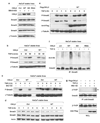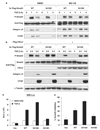Ligand-dependent ubiquitination of Smad3 is regulated by casein kinase 1 gamma 2, an inhibitor of TGF-beta signaling
- PMID: 18794808
- PMCID: PMC2643063
- DOI: 10.1038/onc.2008.337
Ligand-dependent ubiquitination of Smad3 is regulated by casein kinase 1 gamma 2, an inhibitor of TGF-beta signaling
Abstract
Transforming growth factor-beta (TGF-beta) elicits a variety of cellular activities primarily through a signaling cascade mediated by two key transcription factors, Smad2 and Smad3. Numerous regulatory mechanisms exist to control the activity of Smad3, thereby modulating the strength and specificity of TGF-beta responses. In search for potential regulators of Smad3 through a yeast two-hybrid screen, we identified casein kinase 1 gamma 2 (CKIgamma2) as a novel Smad3-interacting protein. In mammalian cells, CKIgamma2 selectively and constitutively binds Smad3 but not Smad1, -2 or -4. Functionally, CKIgamma2 inhibits Smad3-mediated TGF-beta responses including induction of target genes and cell growth arrest, and this inhibition is dependent on CKIgamma2 kinase activity. Mechanistically, CKIgamma2 does not affect the basal levels of Smad proteins or activity of the receptors. Rather, CKIgamma2 preferentially promotes the ubiquitination and degradation of activated Smad3 through direct phosphorylation of its MH2 domain at Ser418. Importantly, mutation of Ser418 to alanine or aspartic acid causes an increase or decrease of Smad3 activity, respectively, in the presence of TGF-beta. CKIgamma2 is the first kinase known to mark activated Smad3 for destruction. Given its negative function in TGF-beta signaling and its reported overexpression in human cancers, CKIgamma2 may act as an oncoprotein during tumorigenesis.
Figures







Similar articles
-
Transforming growth factor-beta repression of matrix metalloproteinase-1 in dermal fibroblasts involves Smad3.J Biol Chem. 2001 Oct 19;276(42):38502-10. doi: 10.1074/jbc.M107081200. Epub 2001 Aug 13. J Biol Chem. 2001. PMID: 11502752
-
RAP250 is a coactivator in the transforming growth factor beta signaling pathway that interacts with Smad2 and Smad3.J Biol Chem. 2008 Apr 4;283(14):8995-9001. doi: 10.1074/jbc.M707203200. Epub 2008 Feb 7. J Biol Chem. 2008. PMID: 18263591
-
Ablation of Smurf2 reveals an inhibition in TGF-β signalling through multiple mono-ubiquitination of Smad3.EMBO J. 2011 Nov 1;30(23):4777-89. doi: 10.1038/emboj.2011.393. EMBO J. 2011. PMID: 22045334 Free PMC article.
-
A tale of two proteins: differential roles and regulation of Smad2 and Smad3 in TGF-beta signaling.J Cell Biochem. 2007 May 1;101(1):9-33. doi: 10.1002/jcb.21255. J Cell Biochem. 2007. PMID: 17340614 Review.
-
The transforming growth factor beta 1/SMAD signaling pathway involved in human chronic myeloid leukemia.Tumori. 2010 Sep-Oct;96(5):659-66. doi: 10.1177/030089161009600503. Tumori. 2010. PMID: 21302608 Review.
Cited by
-
Casein kinase iγ2 impairs fibroblasts actin stress fibers formation and delays cell cycle progression in g1.Int J Cell Biol. 2012;2012:684684. doi: 10.1155/2012/684684. Epub 2012 Mar 7. Int J Cell Biol. 2012. PMID: 22496693 Free PMC article.
-
Adriamycin induces cardiac fibrosis in mice via PRMT5-mediated cardiac fibroblast activation.Acta Pharmacol Sin. 2023 Mar;44(3):573-583. doi: 10.1038/s41401-022-00963-x. Epub 2022 Sep 2. Acta Pharmacol Sin. 2023. PMID: 36056082 Free PMC article.
-
WINNER: A network biology tool for biomolecular characterization and prioritization.Front Big Data. 2022 Nov 4;5:1016606. doi: 10.3389/fdata.2022.1016606. eCollection 2022. Front Big Data. 2022. PMID: 36407327 Free PMC article.
-
Phosphorylation of the anaphase-promoting complex/Cdc27 is involved in TGF-beta signaling.J Biol Chem. 2011 Mar 25;286(12):10041-50. doi: 10.1074/jbc.M110.205518. Epub 2011 Jan 5. J Biol Chem. 2011. PMID: 21209074 Free PMC article.
-
Posttranslational Regulation of Smads.Cold Spring Harb Perspect Biol. 2016 Dec 1;8(12):a022087. doi: 10.1101/cshperspect.a022087. Cold Spring Harb Perspect Biol. 2016. PMID: 27908935 Free PMC article. Review.
References
-
- Bierie B, Moses HL. Tumour microenvironment: TGFbeta: the molecular Jekyll and Hyde of cancer. Nat Rev Cancer. 2006;6:506–520. - PubMed
-
- Davidson G, Wu W, Shen J, Bilic J, Fenger U, Stannek P, et al. Casein kinase 1 gamma couples Wnt receptor activation to cytoplasmic signal transduction. Nature. 2005;438:867–872. - PubMed
-
- Dennler S, Huet S, Gauthier JM. A short amino-acid sequence in MH1 domain is responsible for functional differences between Smad2 and Smad3. Oncogene. 1999;18:1643–1648. - PubMed
Publication types
MeSH terms
Substances
Grants and funding
LinkOut - more resources
Full Text Sources
Other Literature Sources
Molecular Biology Databases

